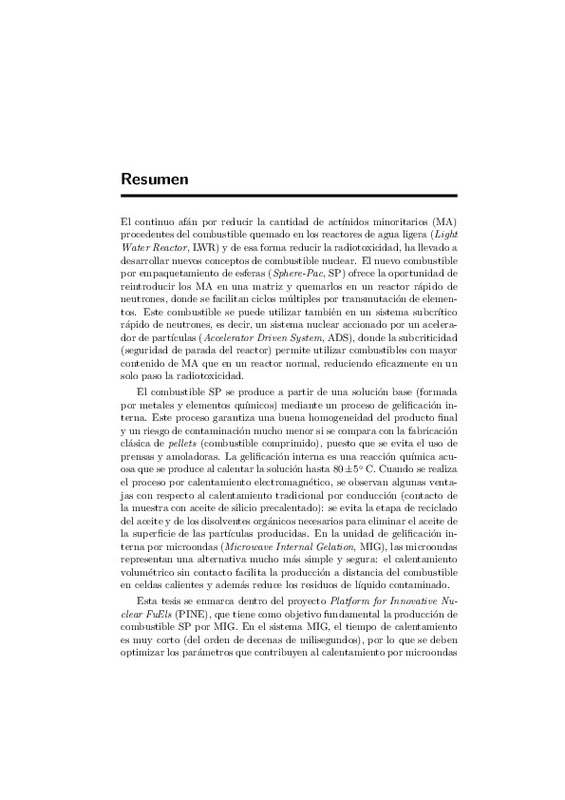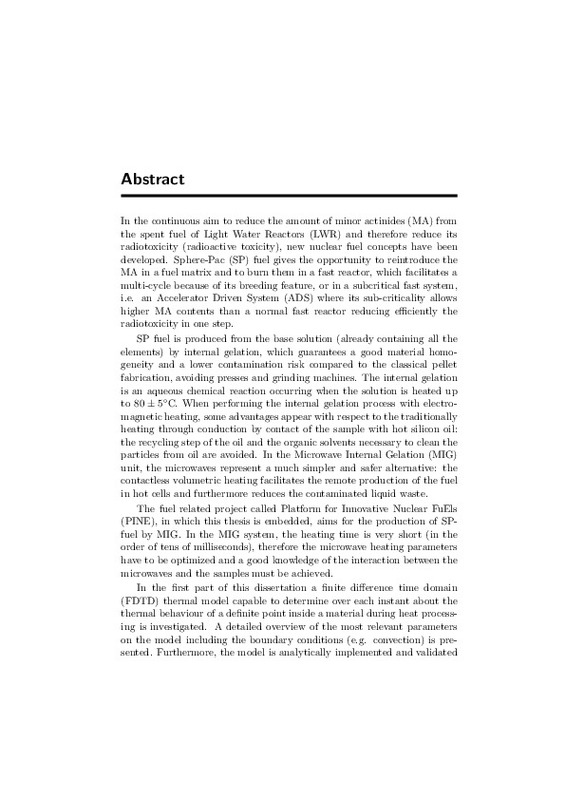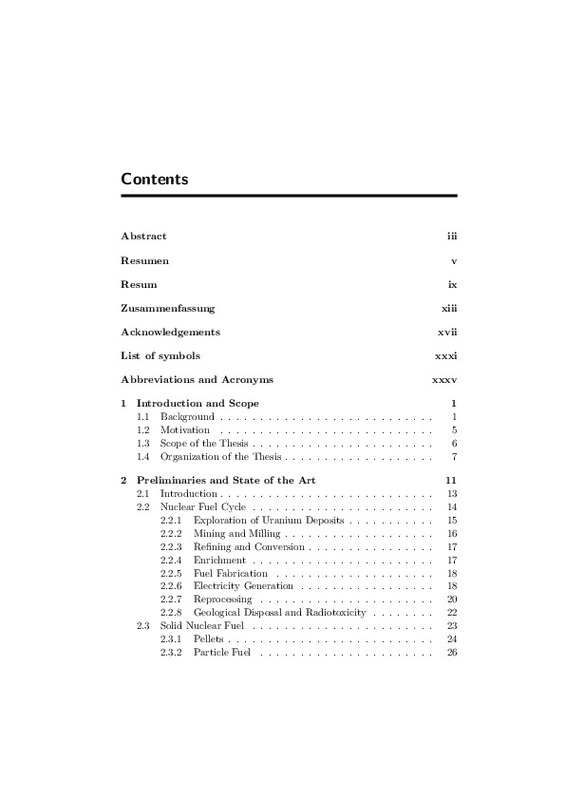- RiuNet repositorio UPV
- :
- Investigación
- :
- Tesis doctorales
- :
- Ver ítem
JavaScript is disabled for your browser. Some features of this site may not work without it.
Buscar en RiuNet
Listar
Mi cuenta
Estadísticas
Ayuda RiuNet
Admin. UPV
Innovative production of nuclear fuel by microwave internal gelation
Mostrar el registro sencillo del ítem
Ficheros en el ítem
| dc.contributor.advisor | Catalá Civera, José Manuel
|
es_ES |
| dc.contributor.advisor | Peñaranda Foix, Felipe Laureano
|
es_ES |
| dc.contributor.author | Cabanes Sempere, Maria
|
es_ES |
| dc.date.accessioned | 2013-09-02T06:36:58Z | |
| dc.date.available | 2013-09-02T06:36:58Z | |
| dc.date.created | 2013-07-19T08:00:17Z | es_ES |
| dc.date.issued | 2013-09-02T06:36:52Z | es_ES |
| dc.identifier.isbn | 978-84-9048-133-2 | |
| dc.identifier.uri | http://hdl.handle.net/10251/31641 | |
| dc.description.abstract | El continuo af'an por reducir la cantidad de act'¿nidos minoritarios (MA) procedentes del combustible quemado en los reactores de agua ligera (Light Water Reactor, LWR) y de esa forma reducir la radiotoxicidad, ha llevado a desarrollar nuevos conceptos de combustible nuclear. El nuevo combustible por empaquetamiento de esferas (Sphere-Pac, SP) ofrece la oportunidad de reintroducir los MA en una matriz y quemarlos en un reactor r'apido de neutrones, donde se facilitan ciclos mu'ltiples por transmutaci'on de elemen- tos. Este combustible se puede utilizar tambi'en en un sistema subcr'¿tico r'apido de neutrones, es decir, un sistema nuclear accionado por un acelera- dor de part'¿culas (Accelerator Driven System, ADS), donde la subcriticidad (seguridad de parada del reactor) permite utilizar combustibles con mayor contenido de MA que en un reactor normal, reduciendo eficazmente en un solo paso la radiotoxicidad. El combustible SP se produce a partir de una soluci'on base (formada por metales y elementos qu'¿micos) mediante un proceso de gelificaci'on in- terna. Este proceso garantiza una buena homogeneidad del producto final y un riesgo de contaminaci'on mucho menor si se compara con la fabricaci'on cl'asica de pellets (combustible comprimido), puesto que se evita el uso de prensas y amoladoras. La gelificaci'on interna es una reacci'on qu'¿mica acu- osa que se produce al calentar la soluci'on hasta 80 ± 5¿ C. Cuando se realiza el proceso por calentamiento electromagn'etico, se observan algunas venta- jas con respecto al calentamiento tradicional por conducci'on (contacto de la muestra con aceite de silicio precalentado): se evita la etapa de reciclado del aceite y de los disolventes org'anicos necesarios para eliminar el aceite de la superficie de las part'¿culas producidas. En la unidad de gelificaci'on in- terna por microondas (Microwave Internal Gelation, MIG), las microondas representan una alternativa mucho m'as simple y segura: el calentamiento volum'etrico sin contacto facilita la producci'on a distancia del combustible en celdas calientes y adem'as reduce los residuos de l'¿quido contaminado. Esta tesis se enmarca dentro del proyecto Platform for Innovative Nu- clear FuEls (PINE), que tiene como objetivo fundamental la producci'on de combustible SP por MIG. En el sistema MIG, el tiempo de calentamiento es muy corto (del orden de decenas de milisegundos), por lo que se deben optimizar los par'ametros que contribuyen al calentamiento por microondas y es necesario conocer en profundidad la interacci'on entre las microondas y las muestras. En la primera parte de este trabajo se investiga un modelo t'ermico basado en diferencias finitas en el dominio del tiempo (FDTD), el cual es capaz de determinar, en cada instante durante el proceso de calentamiento, el comportamiento t'ermico de un punto definido dentro del material que se calienta. Adem'as se presenta una descripci'on detallada de los par'ametros m'as relevantes del modelo, incluyendo las condiciones de contorno (entre ellas la convecci'on). Por otra parte, se implementa anal'¿ticamente y se valida con diferentes t'ecnicas: una basada en teor'¿a de la f'¿sica, otra basada en la herramienta de ecuaciones diferenciales parciales (PDEtools) y la u'ltima basada en ejemplos encontrados en la literatura. En segundo lugar, se investigan los posibles disen¿os de cavidades de microondas para su aplicaci'on en MIG. Tanto las cavidades (selecci'on de los modos, frecuencia de resonancia, factores de calidad, etc.) como su posterior caracterizaci'on, se detallan con el objetivo de especificar el acoplamiento de energ'¿a. Los mecanismos de transferencia de energ'¿a de las cavidades se explican utilizando el m'etodo de perturbaci'on, con el que adem'as se analizan las p'erdidas de la cavidad cuando se coloca una muestra diel'ectrica en su interior. Con el modelo de transferencia de energ'¿a desar- rollado, se obtiene la tasa de generaci'on de calor por microondas, que se aplica al modelo t'ermico FDTD mencionado anteriormente. Los resultados anal'¿ticos demuestran la viabilidad de producir esferas gelificadas por MIG. Seguidamente se introducen los principales par'ametros relacionados con el calentamiento de un material por microondas, es decir, las propiedades diel'ectricas. Se desarrolla un nuevo procedimiento que permite medir estas propiedades en gotas que caen libremente a trav'es de una cavidad de mi- croondas. Se presenta el montaje experimental, cuya viabilidad se prueba a trav'es de diferentes experimentos. Las propiedades diel'ectricas medidas se incluyen en los modelos (perturbacional y t'ermico) con la intenci'on de determinar la potencia absorbida por la sustancia (en forma de gotas) y la temperatura que alcanza. En la u'ltima parte se presenta la implementaci'on del sistema MIG apli- cada al proyecto PINE, fundamental para la pr'actica de calentamiento (basado en frecuencias altas) dentro del laboratorio. Las propiedades de cada dispositivo se evaluan para realizar un estudio de potencia antes del ensamblaje del sistema MIG. De esa forma se evitan fallos al poner el sis- tema en funcionamiento. Adem'as se aportan las t'ecnicas experimentales y los resultados. La producci'on con 'exito de esferas gelificadas demuestra, sin duda, el uso favorable de las microondas en la producci'on de combustible SP por gelificaci'on interna. | es_ES |
| dc.description.abstract | In the continuous aim to reduce the amount of minor actinides (MA) from the spent fuel of Light Water Reactors (LWR) and therefore reduce its radiotoxicity (radioactive toxicity), new nuclear fuel concepts have been developed. Sphere-Pac (SP) fuel gives the opportunity to reintroduce the MA in a fuel matrix and to burn them in a fast reactor, which facilitates a multi-cycle because of its breeding feature, or in a subcritical fast system, i.e. an Accelerator Driven System (ADS) where its sub-criticality allows higher MA contents than a normal fast reactor reducing efficiently the radiotoxicity in one step. SP fuel is produced from the base solution (already containing all the elements) by internal gelation, which guarantees a good material homo- geneity and a lower contamination risk compared to the classical pellet fabrication, avoiding presses and grinding machines. The internal gelation is an aqueous chemical reaction occurring when the solution is heated up to 80 ± 5¿C. When performing the internal gelation process with electro- magnetic heating, some advantages appear with respect to the traditionally heating through conduction by contact of the sample with hot silicon oil: the recycling step of the oil and the organic solvents necessary to clean the particles from oil are avoided. In the Microwave Internal Gelation (MIG) unit, the microwaves represent a much simpler and safer alternative: the contactless volumetric heating facilitates the remote production of the fuel in hot cells and furthermore reduces the contaminated liquid waste. The fuel related project called Platform for Innovative Nuclear FuEls (PINE), in which this thesis is embedded, aims for the production of SP- fuel by MIG. In the MIG system, the heating time is very short (in the order of tens of milliseconds), therefore the microwave heating parameters have to be optimized and a good knowledge of the interaction between the microwaves and the samples must be achieved. In the first part of this dissertation a finite difference time domain (FDTD) thermal model capable to determine over each instant about the thermal behaviour of a definite point inside a material during heat process- ing is investigated. A detailed overview of the most relevant parameters on the model including the boundary conditions (e.g. convection) is pre- sented. Furthermore, the model is analytically implemented and validated with different techniques: a theoretical based physically validation, a par- tial differential equations (PDEtools) based validation and a validation with examples from the literature. Secondly, possible microwave cavity designs for MIG are researched. The cavities (selection of modes, resonant frequency, Q-factor, etc.) and its subsequent characterization for the coupling of energy are explained. Furthermore, the power transfer mechanisms of the cavities are explained using the perturbation method to analyse the losses when a dielectric sam- ple is placed inside a cavity. The developed power transfer model delivers the microwave heat generation rate which is applied to the FDTD thermal model mentioned in the previous paragraph. The analytical results provide a positive impression about the feasibility of producing gelated spheres by MIG. Next, the main parameters dealing with the heating of a material by microwaves are introduced. A new procedure that enables the measure- ment of dielectric properties of aqueous droplets freely falling through a microwave cavity is developed. The experimental setup is presented and several experiments prove its feasibility. The measured dielectric properties are afterwards included in the perturbation and thermal models with the main intention of determining the absorbed power by the material in form of drops and the reached temperature. In the last part the MIG system for the laboratory practice of the high frequency heating applied to the PINE project is implemented. Each device is characterized for a power study precedent to the MIG system assembly, avoiding then failures when putting the system into operation. In addition, the experimental techniques and the results are reported. Successful pro- duction of gelated spheres shows the favourable usage of microwave for the production of SP-fuel by internal gelation. | en_EN |
| dc.language | Inglés | es_ES |
| dc.publisher | Editorial Universitat Politècnica de València | es_ES |
| dc.rights | Reserva de todos los derechos | es_ES |
| dc.source | Riunet | es_ES |
| dc.subject | Geli cació Interna per Microones | es_ES |
| dc.subject | Combustible per Empaquetament d'Esferes | es_ES |
| dc.subject | Cavitats Ressonants | es_ES |
| dc.subject | Freqüència de Reson ància | es_ES |
| dc.subject | Factor de Qualitat | es_ES |
| dc.subject | Propietats Dielèctriques | es_ES |
| dc.subject | Geli cación Interna por Microondas | es_ES |
| dc.subject | Combustible por Empaquetamiento de Esferas | es_ES |
| dc.subject | Cavidades Resonantes | es_ES |
| dc.subject | Frecuencia de Resonancia | es_ES |
| dc.subject | Factor de Calidad | es_ES |
| dc.subject | Propiedades Dieléctricas | es_ES |
| dc.subject | Microwave Internal Gelation | es_ES |
| dc.subject | Sphere-Pac Fuel | es_ES |
| dc.subject | Resonant Cavities | es_ES |
| dc.subject | Resonant Frequency | es_ES |
| dc.subject | Q-factor | es_ES |
| dc.subject | Dielectric Properties | es_ES |
| dc.subject | Perturbation Method. | es_ES |
| dc.subject.classification | TEORIA DE LA SEÑAL Y COMUNICACIONES | es_ES |
| dc.title | Innovative production of nuclear fuel by microwave internal gelation | |
| dc.type | Tesis doctoral | es_ES |
| dc.identifier.doi | 10.4995/Thesis/10251/31641 | es_ES |
| dc.rights.accessRights | Abierto | es_ES |
| dc.contributor.affiliation | Universitat Politècnica de València. Departamento de Comunicaciones - Departament de Comunicacions | es_ES |
| dc.description.bibliographicCitation | Cabanes Sempere, M. (2013). Innovative production of nuclear fuel by microwave internal gelation [Tesis doctoral]. Editorial Universitat Politècnica de València. https://doi.org/10.4995/Thesis/10251/31641 | es_ES |
| dc.description.accrualMethod | TESIS | es_ES |
| dc.type.version | info:eu-repo/semantics/acceptedVersion | es_ES |
| dc.relation.tesis | 8125 | es_ES |
Este ítem aparece en la(s) siguiente(s) colección(ones)
-
Tesis. Editorial UPV [172]
-
Tesis doctorales [5389]












